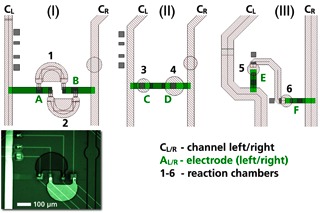The general idea behind the following microreactor designs for concentration cycling is to use alternating concentrations of two different kind of chemicals as amplification mechanism. Three electrode-driving-schemes seem to be feasible.

Design (I) utilize the electroosmotic-flow (EOF) as transport-mechanism. Either the transport of fluid is done from left to right (right to left) or the fluids are cycled throw the two chambers 1 and 2 (clockwise or anti-clockwise). In addition, charged material is concentrated at the electrode of opposite polarity (negative charges are attracted at electrode with positive potential or vice versa). With a suitable time-sequence of the electrodes potentials charged matter can be focused, diluted, focused ad infinitum. Concentration dependent reactions like e.g. chemical PCR might be realized in this design. One key-requirement is using surfaces to which the material is not sticking. Two concentration site per electrode pair have to be stated: firstly the attracting electrode, the material is directly concentrated at the surface, down to atomic layers and secondly right in front of the repelling electrode, because the EOF tries to drag the material passing the repelling electrode (if EOF has suitable polarity). In that case, the material is concentrated in the bulk of the fluid, with probably not that high relative concentration but with no surface disturbing. It remains to be shown how these two different concentration processes might be utilized. The combined white light/fluorescence microscope image shows the practical realization on the Chemical Microprocessor - ChµP.
The central idea behind the two other designs (II) and (III) is to concentrate material in one chamber, while subjecting it to the buffer- or supply solution from the corresponding channel and after reaction happened switching the material to the second chamber with yet another buffer- or supply solution. In (II) diffusive interchange without flow between a side-chamber and a main channel is modulated by the voltage on electrodes across the shallow connecting channel.This cycling between to chambers essentially allows the use for applications like chemical PCR and concentration dependent reactions.





